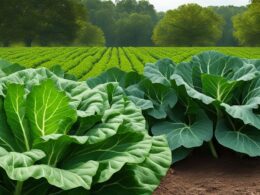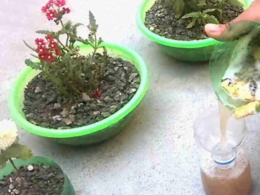If you’ve ever wondered whether you can dissolve granular fertilizer in water, the answer is yes! In this article, we’ll explore the process of turning granular fertilizer into a liquid, as well as the benefits of using liquid fertilizer compared to granular. Whether you’re a seasoned gardener or just starting out, understanding the different options for fertilizing your plants can help you make the best choice for their health and growth.
Post Summary
- Granular fertilizer can be dissolved in water to create a liquid fertilizer.
- Liquid fertilizer is fast-acting and can provide immediate nutrients to plants.
- Turning granular fertilizer into liquid is a simple process of soaking and straining.
- Both liquid and granular fertilizers have their advantages and drawbacks.
- Understanding the benefits of each type can help you choose the optimal fertilizer for your plants.
Why Use Liquid Fertilizer Instead of Granular?
When it comes to fertilizing your plants, you may have heard about the benefits of using liquid fertilizer instead of granular. Liquid fertilizer, as the name suggests, is in a liquid form and is known for its fast-acting nature. It can be quickly absorbed by plants, providing them with the nutrients they need in a shorter period of time.
One of the advantages of liquid fertilizer is its ability to be easily absorbed by plants, making it an ideal choice for situations where immediate nutrient uptake is necessary. For example, during cold weather conditions, when granular fertilizer may break down slowly, liquid fertilizer can provide plants with the necessary nutrients more rapidly.
Another benefit of using liquid fertilizer is its suitability for certain landscape settings. Liquid fertilizer can be applied evenly through watering or foliar feeding, ensuring that all plants receive an equal amount of nutrients. This can be particularly advantageous if you have a large garden or different types of plants with varying nutrient requirements.
“Liquid fertilizer can act as an ‘energy drink’ for plants, giving them an immediate boost in health.”
In addition to its fast-acting nature and easy absorption, liquid fertilizer also has the advantage of deterring dogs from digging in the garden beds. Unlike granular fertilizer, which can be enticing to pets, liquid fertilizer is less appealing and can help protect your plants from unwanted digging.
| Benefits of Liquid Fertilizer | Benefits of Granular Fertilizer |
|---|---|
| Fast-acting | Slow-release |
| Easily absorbed by plants | Long shelf-life |
| Even application through watering or foliar feeding | Ease of storage |
| Acts as an “energy drink” for plants | Cost-saving |
| Deters dogs from digging in garden beds |
How to Turn Granular Fertilizer into Liquid
If you have granular fertilizer on hand but prefer to use liquid fertilizer for your plants, you can easily convert the granules into a liquid form. This process allows for faster absorption and more even distribution of nutrients. Follow these simple steps to turn your granular fertilizer into a liquid:
- Start by measuring the amount of granular fertilizer you wish to convert. The general ratio is 1 cup of fertilizer per gallon of water, but you can adjust the ratio based on the specific needs of your plants.
- Add the measured amount of granular fertilizer to a container.
- Pour the corresponding amount of water into the container, ensuring that all the granules are submerged.
- Stir the mixture periodically over a 24-hour period to help the granules dissolve and release their nutrients into the water.
- After 24 hours, strain the liquid to remove any undissolved granules or debris.
- Your liquid fertilizer is now ready to use! Apply it to your plants at the recommended rates for each type of plant.
Remember to wear gloves and follow safety precautions when handling fertilizer, whether in granular or liquid form. Always refer to the instructions on the fertilizer packaging for specific guidelines and recommendations.
Benefits of Using Liquid Fertilizer
Using liquid fertilizer provides several advantages for your plants. Here are some benefits worth considering:
- Faster absorption: Liquid fertilizer is quickly absorbed by plant roots, allowing for faster nutrient uptake and utilization.
- Even distribution: When applied as a liquid, fertilizer is more evenly distributed across the plant’s root zone, ensuring that all parts of the plant receive the necessary nutrients.
- Precise application: Liquid fertilizer can be easily measured and applied with accuracy, making it convenient for plants with specific nutrient requirements.
- Foliar feeding: Liquid fertilizer can also be used for foliar feeding, which involves applying the fertilizer directly to the leaves for rapid nutrient absorption.
By following the simple steps to convert granular fertilizer into a liquid form, you can enjoy the benefits of liquid fertilizer for your plants and ensure they receive the nutrients they need for healthy growth.
| Fertilizer Recipe | Ingredients | Application Rate |
|---|---|---|
| Liquid Kelp Fertilizer | Kelp meal, Water | Dilute with water for foliar feeding or use as a watering solution |
| Homemade Organic Liquid Fertilizer | Compost manure, Green matter, Water | Use as a watering solution |
Benefits of Granular Fertilizer
Granular fertilizer offers several advantages for gardeners and farmers. Here are some key benefits of using granular fertilizer:
- Slow-release nutrients: Granular fertilizers are designed to release nutrients slowly over time, providing a steady supply of essential elements to plants. This slow-release feature ensures that plants receive a consistent nutrient supply, reducing the risk of over-fertilization and nutrient leaching.
- Cost-saving: Granular fertilizers are generally more cost-effective than liquid fertilizers. They are available in larger quantities and can cover a larger area, making them a budget-friendly choice for those with extensive gardens or agricultural fields.
- Long shelf-life: Unlike liquid fertilizers that may have a limited shelf-life, granular fertilizers have a longer storage life. This means you can purchase granular fertilizer in bulk and use it as needed without worrying about it expiring.
“Granular fertilizers provide slow-release nutrients, making them a reliable choice for landscaping and agricultural applications. Their cost-saving benefits and long shelf-life make them a popular option for many gardeners.”
While granular fertilizer offers these advantages, it’s important to note that there are also other considerations to keep in mind. Granular fertilizers may not provide immediate nutrients to plants, unlike liquid fertilizers that are quickly absorbed. Additionally, granular fertilizers can be challenging to measure and distribute evenly. However, when used correctly and in accordance with plant nutrient requirements, granular fertilizers can be an effective and efficient way to nourish your plants.
Comparison of Granular and Liquid Fertilizers
| Granular Fertilizer | Liquid Fertilizer | |
|---|---|---|
| Nutrient Release | Slow-release | Fast-acting |
| Application | Spread on soil or around plants | Watered into soil or sprayed on leaves |
| Cost | Generally more cost-effective | Higher cost per application |
| Storage | Long shelf-life | May have a limited shelf-life |
| Application Control | Requires careful measurement and distribution for even coverage | Easier to control application rates and coverage |
It’s important to consider your specific needs and circumstances when choosing between granular and liquid fertilizers. Factors such as plant type, growth stage, and nutrient requirements will influence the optimal fertilizer choice. Whether you opt for granular or liquid fertilizers, providing your plants with the necessary nutrients will help ensure their health and vitality.
Drawbacks of Granular Fertilizer
While granular fertilizer has its benefits, it also has some drawbacks that you should be aware of before using it in your garden. One of the main disadvantages is the potential for uneven application of nutrients. Each granule can have varying amounts of nutrients, which means that some plants may receive more nutrients than others, leading to an imbalance in their growth.
“Uneven application of granular fertilizer can result in some plants becoming over-fertilized while others suffer from nutrient deficiencies.”
Another drawback of granular fertilizer is the risk of leaf burn. Granular fertilizer has a high salt content, and if applied in excess, it can burn the leaves of plants. This is especially true if the fertilizer comes into direct contact with the foliage. It’s crucial to carefully follow the recommended application rates to avoid this issue.
To mitigate the risk of leaf burn and ensure even nutrient distribution, it’s recommended to dissolve granular fertilizer in water before applying it to your plants. Soaking the fertilizer in water helps to break down the granules and allows for better absorption of nutrients by the plants.
| Drawback | Description |
|---|---|
| Uneven Application | Each granule can have varying amounts of nutrients, leading to imbalanced growth. |
| Leaf Burn | High salt content in granular fertilizer can cause leaf burn if applied in excess or in direct contact with the foliage. |
Considering these drawbacks, it’s important to carefully choose the type of fertilizer that best suits your needs and the specific requirements of your plants. If you decide to use granular fertilizer, make sure to follow the recommended application rates and consider dissolving it in water for more even distribution of nutrients.
Benefits of Liquid Fertilizer
Liquid fertilizer offers numerous advantages that can greatly benefit your plants. One of the key advantages is its fast-acting nature. The nutrients in liquid fertilizer are readily available for plants to absorb, providing them with an immediate boost in health. This is particularly beneficial for plants that require an immediate nutrient infusion or are showing signs of nutrient deficiencies.
Additionally, liquid fertilizer is easily absorbable by plants. The liquid form allows for better access to immobile nutrients, ensuring that your plants can efficiently uptake the essential elements they need for growth. This can result in healthier and more vigorous plants, with improved overall development and increased resistance to stress factors.
“The fast-acting and easily absorbable nature of liquid fertilizer can provide plants with the immediate boost they need for optimal growth and development.”
Another advantage of liquid fertilizer is its versatility in application. It can be easily applied to plants through watering or foliar feeding. This allows for even coverage and efficient distribution of nutrients, ensuring that every part of the plant receives the necessary nourishment. Liquid fertilizer can also be diluted to meet the specific needs of different plant types, making it a flexible option for a variety of gardening or agricultural settings.
In conclusion, the benefits of liquid fertilizer include its fast-acting nature, easy absorbability, and versatility in application. By using liquid fertilizer, you can provide your plants with the immediate nutrients they need for optimal growth and development. Whether you have newly planted seedlings, plants with nutrient deficiencies, or simply want to give your garden an extra boost, liquid fertilizer can be a valuable tool in your gardening arsenal.
Table: Comparison of Liquid and Granular Fertilizers
| Advantages | Liquid Fertilizer | Granular Fertilizer |
|---|---|---|
| Speed of Action | Fast-acting | Slower release |
| Absorption Rate | Easily absorbable | Varies based on soil conditions |
| Application Method | Can be applied through watering or foliar feeding | Applied to soil or sprinkled around plants |
| Access to Nutrients | Improves access to immobile nutrients | Less accessible to plants without dissolving |
| Customization | Dilutable for specific needs | Standardized application rates |
Conclusion
When it comes to choosing between liquid and granular fertilizer, it ultimately depends on your specific needs and circumstances. Both types have their own advantages and drawbacks.
Liquid fertilizer is a great choice if you’re looking for fast-acting nutrients that are easily absorbed by plants. It provides an immediate boost in health and is ideal for plants that need a quick nutrient fix. However, it may require more frequent applications.
On the other hand, granular fertilizer offers a longer shelf-life and is cost-effective. It provides slow-release nutrients over time, making it a convenient choice if you prefer less frequent applications. However, it may not provide even distribution of nutrients and can be challenging to estimate the right amount to use.
Ultimately, the optimal fertilizer choice depends on factors such as the type of plants you have, the specific nutrient deficiencies they may have, and the weather conditions in your area. Understanding the benefits and drawbacks of both liquid and granular fertilizers will help you make an informed decision that maximizes plant nutrient absorption and promotes overall plant health.
FAQ
Can you dissolve granular fertilizer in water?
Yes, you can turn granular fertilizer into a liquid by soaking it in water for 24 hours, stirring periodically. After soaking, strain out the solids and use the liquid as a fertilizer.
Why use liquid fertilizer instead of granular?
Liquid fertilizer is fast-acting and easily absorbed by plants. It provides immediate nutrients, especially beneficial for new plants, seedlings, and those with nutrient deficiencies.
How to turn granular fertilizer into liquid?
To convert granular fertilizer into liquid, soak the granules in water for 24 hours, using 1 cup of fertilizer for each gallon of water. Stir periodically, then strain out the solids and use the liquid as a fertilizer.
Are there other liquid fertilizer recipes?
Yes, liquid kelp fertilizer can be made by soaking kelp meal in water and puréeing or muddling it to create a paste. Fresh sea kelp can also be added to water, stirred for three days, strained, and diluted for use as liquid fertilizer.
What are the benefits of granular fertilizer?
Granular fertilizer has a long shelf-life, is easy to store, and is cost-saving. It provides slow-release nutrients over time and can be incorporated into the soil or sprinkled around the base of plants.
What are the drawbacks of granular fertilizer?
Granular fertilizer may not provide even application of nutrients, as each granule can have varying amounts. It can limit a plant’s access to immobile nutrients and has a risk of leaf burn if used excessively due to its high salt content.
What are the benefits of liquid fertilizer?
Liquid fertilizer offers fast-acting nutrients that are readily absorbed by plants. It provides better nutrition and access to immobile nutrients. It is also easily applied through watering or foliar feeding.
What should be considered when choosing between liquid and granular fertilizer?
The choice between liquid and granular fertilizer depends on specific needs and circumstances, such as plant type, nutrient deficiency, and weather conditions. Understanding the benefits and drawbacks of each type can help make an informed decision on optimizing plant nutrient absorption and overall plant health.
Can Granular Fertilizer Also Be Used to Make Liquid Fertilizer?
Yes, granular fertilizer can be used for making liquid fertilizer. By dissolving the dry fertilizer in water, you can create a liquid fertilizer solution that can be easily sprayed onto plants. This method provides a convenient alternative for applying fertilizers to your garden or crops.












